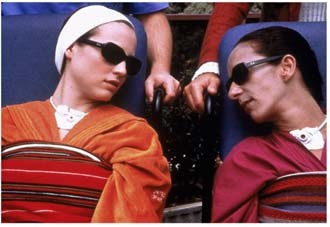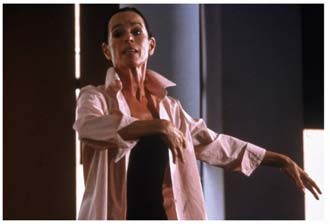Pedro Almodóvar's latest film opens with a rising curtain, and it's filled to the brim not only with performing artists — dancers, musicians, bullfighters — but with vivid examples of them at work. On the other hand, its plot revolves around two artists who, in terminal comas, are unable to perform in any way.
In the opening scene, a modern dance piece in which a woman sleepwalks across a stage, while a sad stagehand scurries ahead of her, clearing whatever path she seems to be taking, we are introduced to the two men who form the audience for both the lively arts and the vegetative ones: Marco and Benigno, each of whom is devoted to one of the comatose women. Almodóvar has always been known for his compelling female characters, and here he's able to make these actresses the leads even the during long stretches when they're inert (both women do get to speak, in prolonged flashbacks); the men in their lives really only exist to observe them, to create the appropriate air of melancholy and longing, to talk to their loved ones and hope they hear. (Even the great Caetano Veloso, during a spellbinding musical interlude, is here to lull the audience into a sweet sadness.)
This is the Spanish director's most elegant film; as graceful as the dancers and toreadors are, Almodóvar matches them with an effortless style which reminds you that the best filmmakers are also performing artists. The picture is full of visual and thematic echoes of itself. Over and over, a figure is seen stretched out horizontally in the frame; there's a sensory pleasure to the repetition, but the final iteration also serves as a kind of oblique commentary on what's been happening throughout the film. The elaborate ritual by which nurses change a patient's robe while carefully avoiding her naked body is balanced against a scene in which a female bullfighter is squeezed into her embroidered velvet armor. The parallels occasionally focus on men, too: In a very late scene, meticulously planned camera movements take advantage of a labyrinth of plate glass to superimpose Marco's reflection onto Benigno's face, then vice-versa. Though certainly the result of laborious preparation, the effect doesn't jump out at you — like so many of the film's visual touches, though, it plants seeds in the subconscious, suggesting unseen transformations in the characters.
The director's first films to find success in the States were comedies, and some audiences always seem to hope that he'll return to that early, funnier mode. Talk to Her, despite a couple of outrageously comic moments, is not a comedy. It does give us a character, Benigno, whose fantasy life is ripe for ridicule, but Almodóvar is so sympathetic to the man — a nurse who apparently replaces his desire for an active homosexual relationship with a static, imaginary heterosexual one — that we root for him instead of laughing.
All the while, two women who can't open their eyes are keeping these men — and, as their back stories are investigated in flashbacks, this film — in a holding pattern, unable to go on with their lives. It's the sweetest, most beautiful flight delay you could hope for. •


